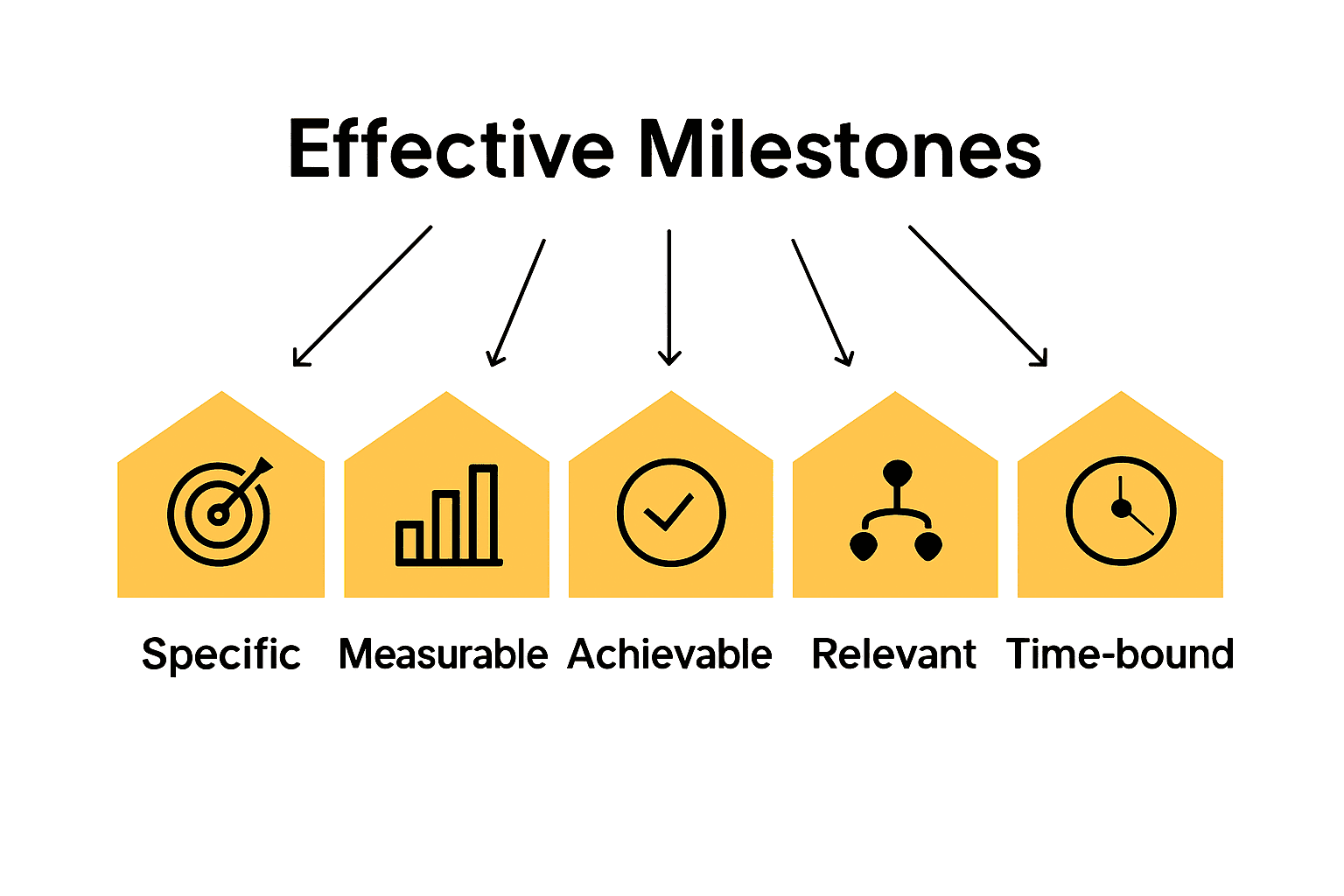Most american project managers agree that missing key milestones can throw entire timelines off course. With over 80 percent of projects facing delays from unclear or poorly tracked milestones, knowing how to define and manage these checkpoints becomes critical for team success. Understanding the strategic role of milestones helps transform complex projects into manageable steps, while also keeping everyone focused and accountable through every stage of the process.
Table of Contents
- Defining Milestones In Project Management
- Types Of Milestones And Use Cases
- Essential Characteristics And Functions
- Setting, Tracking, And Measuring Milestones
- Risks, Pitfalls, And Best Practices
Defining Milestones in Project Management
In the dynamic world of project management, milestones serve as critical navigation points that help teams track progress, align expectations, and maintain strategic momentum. According to Wikipedia, milestones are specialized tools used to mark specific points along a project timeline, highlighting significant events like project start and end dates, external reviews, or crucial budget checkpoints.
These strategic markers do more than simply track time. As Coursera explains, project milestones indicate major goals or events within a project’s lifecycle, providing teams with clear indicators of progression through different phases. They act as visual and organizational checkpoints that help project leaders assess momentum, realign resources, and communicate advancement to stakeholders.
Understanding milestones involves recognizing their core functions in project management. Effective milestones typically share several key characteristics:
- Represent significant accomplishments or transition points
- Provide a clear, measurable indicator of progress
- Enable precise tracking of project development
- Facilitate communication between team members and stakeholders
- Offer opportunities for reflection and potential course correction
By strategically implementing milestones, project managers transform abstract timelines into concrete, actionable frameworks. These markers transform complex projects into manageable segments, allowing teams to maintain focus, celebrate achievements, and proactively address potential challenges before they become critical roadblocks.
Types of Milestones and Use Cases
Project managers have developed sophisticated approaches to milestone tracking, with distinct categories designed to address specific organizational needs. According to DSC, there are three primary types of milestones: decision milestones, progress milestones, and event milestones. Each type serves a unique purpose in guiding project progression and ensuring strategic alignment.
Decision milestones represent critical junctures where project teams evaluate current status and determine next steps. These might include go/no-go decisions that determine whether a project should continue, pivot, or terminate. Progress milestones track interim achievements and final goals, providing tangible evidence of project advancement. Event milestones mark specific occurrences like key meetings, document receipts, or external reviews that signal important transitions.
Additionally, Doing Projects highlights other milestone classifications that add depth to project management strategies:
- Coordination Points: Moments requiring simultaneous work completion across different project domains
- Approval Milestones: Internal and external checkpoints for validating project components
- Liability Transfer Milestones: Points where responsibility shifts between project team members or stakeholders
These diverse milestone types transform project management from a linear process into a dynamic, adaptive framework.
 By strategically selecting and implementing appropriate milestones, teams can create robust tracking mechanisms that provide clarity, accountability, and continuous improvement throughout the project lifecycle.
By strategically selecting and implementing appropriate milestones, teams can create robust tracking mechanisms that provide clarity, accountability, and continuous improvement throughout the project lifecycle.
Essential Characteristics and Functions
Project milestones are not just arbitrary checkpoints, but sophisticated management tools with precise characteristics that drive organizational success. According to Stiftung 3M, effective milestones should be SMART: Specific, Measurable, Achievable, Relevant, and Time-bound. This framework transforms milestones from simple markers into strategic planning and controlling instruments that help teams evaluate progress and quickly identify potential deviations.
Specificity is the cornerstone of meaningful milestones. They must articulate clear, unambiguous objectives that leave no room for misinterpretation. Measurability ensures that progress can be quantified, allowing teams to track advancement objectively. Achievability prevents setting unrealistic expectations, while relevance guarantees that each milestone directly contributes to broader project goals. The time-bound aspect creates accountability by establishing precise deadlines for completion.

As Doing Projects highlights, milestones serve multiple critical functions in project management:
- Provide a simplified project overview
- Divide complex projects into manageable segments
- Facilitate comprehensive schedule assessment
- Enhance communication among team members and stakeholders
- Create natural points for reflection and potential strategy adjustment
By embedding these essential characteristics, project leaders transform milestones from passive tracking tools into dynamic mechanisms for strategic navigation. They become more than mere checkpoints—they evolve into powerful instruments that guide teams through complex initiatives, maintain alignment, and drive consistent, measurable progress toward organizational objectives.
Setting, Tracking, and Measuring Milestones
Effective milestone management requires a strategic approach that transforms abstract project goals into concrete, measurable achievements. According to Coursera, milestones serve as critical scheduling tools that help project teams identify when major goals should be accomplished, enabling precise planning of necessary steps, resources, and actions.
Setting milestones demands careful consideration and strategic thinking. Project managers must create markers that are not just arbitrary checkpoints, but meaningful indicators of genuine progress. This involves identifying key transition points, potential bottlenecks, and critical decision-making moments throughout the project lifecycle. Each milestone should represent a significant achievement that moves the project closer to its ultimate objective, providing clear visibility into overall advancement.
Wikipedia highlights the power of integrating milestones with advanced scheduling methodologies like PERT (Program Evaluation and Review Technique) and CPM (Critical Path Method). These approaches enable project leaders to:
- Accurately determine project schedule adherence
- Constrain and calculate specific milestone dates
- Identify potential project float or scheduling flexibility
- Pinpoint critical path dependencies
- Assess resource allocation effectiveness
Tracking milestones requires ongoing vigilance and a systematic approach. Successful project managers develop robust monitoring mechanisms that provide real-time insights into milestone progression. This might involve regular status meetings, comprehensive reporting tools, visual dashboards, or integrated project management software that allows instant assessment of milestone completion rates, potential delays, and required corrective actions.
Risks, Pitfalls, and Best Practices
Milestone management is a nuanced process fraught with potential challenges that can derail project success if not carefully navigated. According to Wikipedia, one significant risk is that milestones often only monitor progress on the critical path, potentially creating a misleading impression of project advancement by inadvertently ignoring noncritical activities that might still impact overall project health.
Risk mitigation requires a comprehensive approach that goes beyond simple tracking. Project managers must develop a holistic view that considers both critical and noncritical project elements. This involves creating redundant monitoring systems, maintaining open communication channels, and establishing flexible milestone frameworks that can adapt to unexpected challenges. The key is to view milestones as dynamic tools rather than rigid checkpoints, allowing for real-time adjustments and strategic recalibration.
Stiftung 3M emphasizes the transformative potential of milestone tracking as a continuous learning mechanism. Best practices for effective milestone management include:
- Regularly review and revise milestone assumptions
- Celebrate achieved milestones to maintain team motivation
- Identify both positive and negative project deviations
- Implement transparent reporting mechanisms
- Create buffer zones for unexpected complications
- Develop contingency plans for potential milestone delays
Successful milestone management is less about perfect prediction and more about creating adaptive, resilient project frameworks. By embracing flexibility, maintaining clear communication, and viewing milestones as opportunities for learning and improvement, project leaders can transform potential pitfalls into strategic advantages that drive consistent organizational success.
Boost Your Project Success with Strategic Milestone Management
Milestones are more than just dates on a calendar. They are vital signals for project leaders to assess progress, communicate with teams, and adjust plans before risks escalate. If you feel overwhelmed by tracking and managing multiple milestones while keeping your team aligned, you are not alone. The key challenge lies in transforming complex project timelines into actionable steps that guarantee visibility and control across all phases.
Gammatica.com understands these pain points. Our AI-driven platform is designed to simplify the entire milestone process by automating task management, enabling seamless calendar coordination, and enhancing team collaboration. With features like customizable checklists and Kanban boards tailored for precise milestone tracking, you can transform vague objectives into SMART achievements while saving up to 16 hours every week by reducing administrative overload. Take control of your project’s critical checkpoints, ensure all progress and decision milestones are met, and keep your team motivated with transparent communication.
Ready to turn milestones into milestones of success?
 Explore how automation and AI-powered project management at Gammatica.com bring clarity and agility to your projects. Start streamlining your milestones and unlock your team’s full potential today. Visit Gammatica.com to get started and experience organized, smart, and scalable project success like never before.
Explore how automation and AI-powered project management at Gammatica.com bring clarity and agility to your projects. Start streamlining your milestones and unlock your team’s full potential today. Visit Gammatica.com to get started and experience organized, smart, and scalable project success like never before.
Frequently Asked Questions
What are milestones in project management?
Milestones in project management are specific points along a project timeline that mark significant events or accomplishments, such as project start and end dates, external reviews, or critical budget checkpoints.
What are the different types of milestones?
There are three primary types of milestones: decision milestones, progress milestones, and event milestones. Decision milestones involve critical evaluations, progress milestones track interim achievements, and event milestones mark specific occurrences in the project lifecycle.
How do you set effective milestones for a project?
Effective milestones should be SMART: Specific, Measurable, Achievable, Relevant, and Time-bound. This strategy ensures that milestones are clear indicators of genuine progress, representing significant achievements that contribute to broader project goals.
What are some common risks associated with milestone management?
Common risks include focusing too narrowly on critical path milestones, which can create a misleading impression of project progress. To mitigate this risk, project managers should consider both critical and noncritical activities and have flexible milestone frameworks that adapt to challenges.



